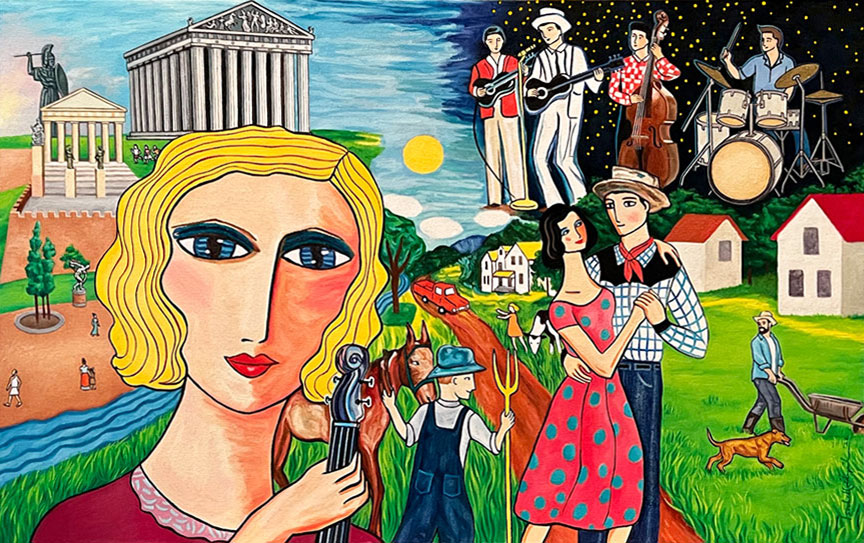
The One Voice Addendum
Oil on canvas
25″ x 40″ x 1.5″
I post the technical aspects of my work on my website because the finished piece is always only the tip of the proverbial iceberg. All my paintings are results of the curated distillate of ideas, research (so I don’t end up reinventing the wheel), and stuff in between. Stanislaw Szukalski’s description of “copying” is “photographic taxidermy”. It’s like memorizing the words of a language without stringing them into sentences and paragraphs. This is why even when I’m commissioned to make a version of an existing artwork, it inevitably evolves into something else.
While the people who know me personally can attest to my obsession with black, there isn’t a single drop of black paint on this painting. The reason all boils down to a little bit of Classical Color Theory about Photonic-light (e.g. infrared, ultraviolet, x-rays, gamma rays, the light from your monitor, phone… etc.) versus pigment such as paint or ink.
First and foremost, neither black nor white are colors in the first place. In terms of photonic-light, white is the presence of all color while black is the absence of it. This is why sunlight, through a spectrum turns into a rainbow. Meanwhile, an appropriate corresponding example for black would be a black hole. It implodes into nothingness, a void –making black more like negative space.
These qualities are quite different when it comes to pigment/paint where white becomes the absence of all color while black contains all of it. Black pigment also absorbs light, so it is true that a black shirt on a hot day can make you feel warmer (even if I haven’t really noticed). From personal experience, pigment-based black really does contaminate your palette significantly. Since it contains all colors, it can turn a pure color into mud. You can even say that its light absorbing qualities steal the light reflecting off the other colors, making things look visually dull. Don’t get me wrong, black is extremely important. It just needs to be used wisely.
A tried and tested solution that addresses the potential issues of using real black paint in a colorful painting is called “chromatic black”, or “color black”. Since black is the presence of all color anyway, one mixes all their darkest colors to create an illusion of black. Then there’s no excess baggage.
Now that black is out of the way, what exactly is this painting about anyway?


It is based on the album cover for the 1996 Greek Olympics soundtrack called “One Voice”. This Olympics was particularly sentimental to the client because he qualified to compete as a skeet shooter. As usual, our very “honorable” Philippine Sports Commission claimed to not have the funds to send our athletes to Greece. The principles of some organizations are simply too “incorruptible” to support them.
Since the original reference for the painting was quite small, the client gave me free rein to interpret and improvise as I saw fit. There was also an issue about scale since a rectangular painting was preferred while the original was a square. Therefore the things happening on the left and right of the final piece are purely my own design.
In the original, day and night were happening simultaneously. This idea was expanded into morning, noon, and night, which we can then relate to the archetypal dawn, zenith, and dusk of one’s life. One can also compare this to the past, present, and future, which gives relevance to the added references to Ancient Greece. The river in the original was inevitably transformed into the river of time –which the journey of life flows through.
The Expanded Left
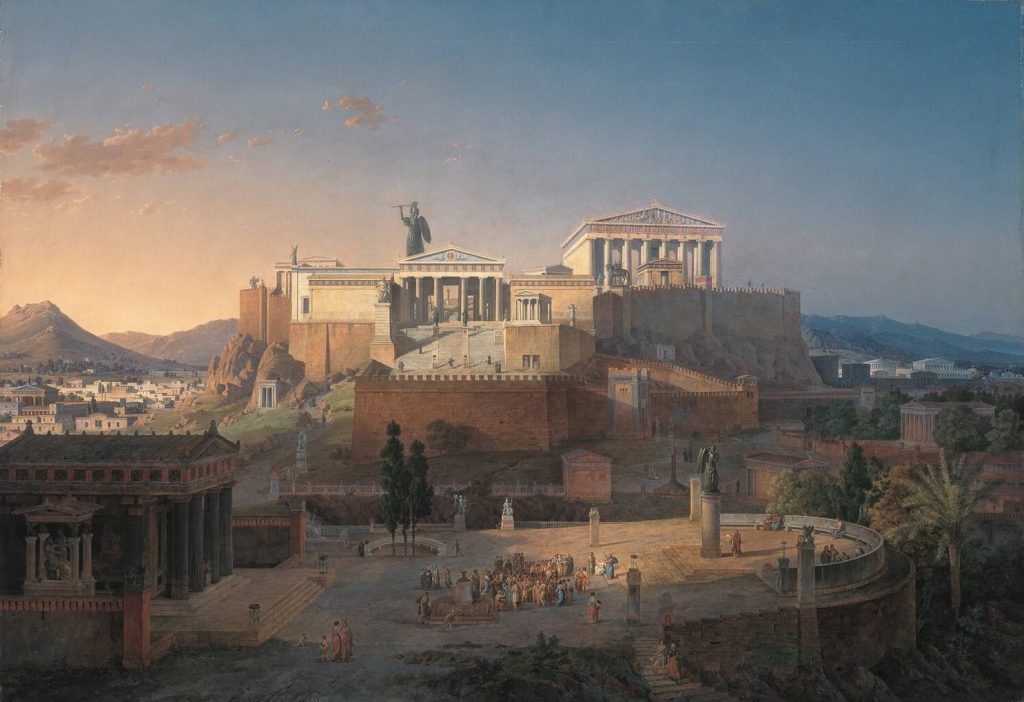
The framework for my entire Ancient Greece portion on the left comes from this rendition of the Acropolis by German painter, architect, and writer, Leo Von Klenze. Athena aside, not being able to construe the statues in his painting made me search for relevant yet creative substitutions. While the white marble statue of historian-general-philosopher Xenophon and the two Korai (maiden figures), might not be too far fetched, the Discobolus statue is really “unofficial” even if this sculpture is from a proximal period in time. Still, the Discobolus remains a prominent symbol of Greek athletics –a good reminder that the Olympics originated in Greece after all.

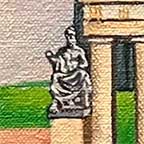
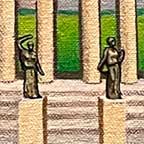
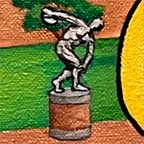
The Expanded Right
It was much easier to create content for the right side of the painting because no live band would be complete without a drummer playing blast beats (LOL). The road and landscape simply had to be extended for the painting to make sense. But, to give the painting a visual dialogue, I made it appear that the boy holding the donkey was talking to the man with the wheelbarrow in the field. Also, a happy farm should have a dog.
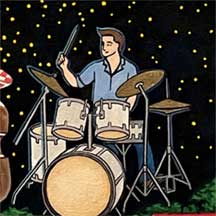
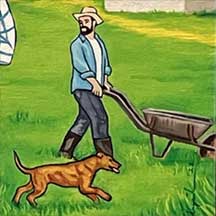


They say the devil is in the details so even minor elements such as the length of grass were considered. Wouldn’t it have been strange if the grass on the right were as lush as it is on the middle and left if the cow had been eating it all day?
More Adjustments
Prior to beginning this commission, it was my first time to encounter this passage from the Bible:
“Except ye be converted, and become as little children, ye shall not enter onto the kingdom of heaven.” – Matthew 18:3
Yikes! The innocence and spontaneity of the strokes, or how the brush was not thoroughly cleaned so it bled previously used colors into new ones are instant indications that the original painter was VERY VERY YOUNG. No doubt it gave the original a particular charm, but it is not in my character to replicate the nature of another individual. Just imagining re-using a dirty brush makes my head hurt! I definitely cannot become as a little child when it comes to my work. Hopefully there’s time yet to figure the heaven part out.
Other compulsively (perhaps even compulsorily) improved elements:
1. The Acropolis – This work’s cartoon like abstraction did not require perfectly straight lines, but more symmetry and detail were added. I also found the black bird distracting.

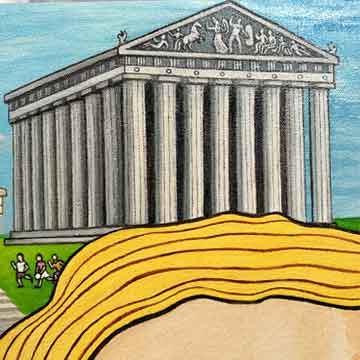
2. The texture of the paper was visible on the original painting making it most likely a watercolor (with pencil or crayon on top). Simulating the paper texture felt pointless, and the color treatment became shape-based instead of line-based. A good example is the rouge on the blonde woman’s cheeks. Mimicking the original pencil made it look like the blonde woman tripped and scraped her face!

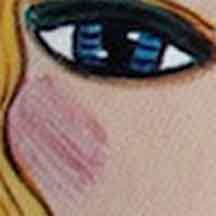
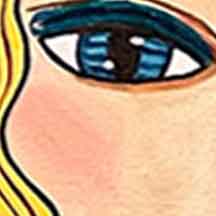

3. There were some minor adjustments to improve the overall proportions and balance, e.g. the angles and thicknesses of limbs and certain outlines. Even if the painting was intentionally brightened, the reduction of lines added to the effect.
4. The upright bass in the original looked like it was stolen from a Black Metal band (It would have worked really well for a different occasion). A more traditional looking instrument felt appropriate. I also made sure that the tuning pegs are facing backwards and not sideways so that it would not be mistaken for a cello, + improved the strings. It’s worth mentioning that the photograph on the right captures the dark blue shades of the night sky more accurately.
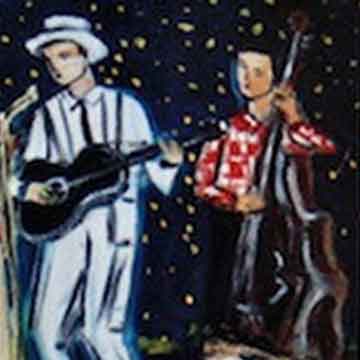

Not-So-Random Facts:
1. Again no black paint was used on this painting.
2. No rulers or guides were used either and the entire painting was made in freehand. Like the illusion of chromatic black, the straight lines of the Acropolis, or even the upright bass strings are not as straight as they seem.
3. This painting continues seamlessly on all four sides, making a frame unnecessary.
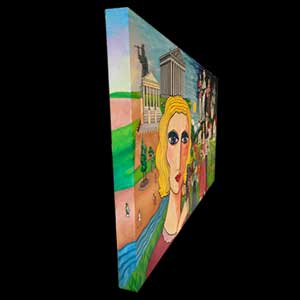
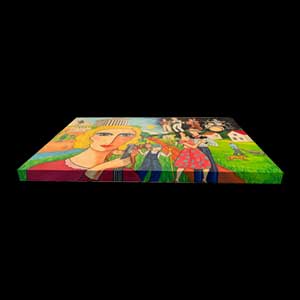
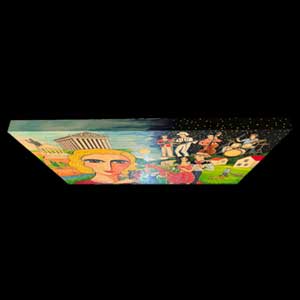
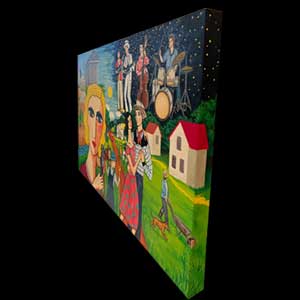
4. I used three different kinds of red, two different yellows, three different blues, two greens, two browns. Colors are not born equal.
Conclusion
All of this would be nonsense if the final painting were not intentionally “Gestaltian”. The whole should not only be greater than the sum of its parts, but a person unfamiliar with the original should find the entire composition with its new additions credible and enjoyable.
My interpretation of what is going on is that the blonde girl holding a fiddle was late to their scheduled performance. She was the only person with a tuner and her bandmates had to start without her. While it wasn’t horrible, the off-key micro-intonations transcended the river of time and irritated the Goddess Athena, making her animate the statue of herself so it could hurl a magic spear at the band.
The brown haired boy with the mule and the blonde child beside the cow are looking forward to seeing their dad, who is arriving in the red pickup truck. The farmhand with the wheelbarrow is trying to warn the other farmhand of their boss’ arrival, because he is dancing with the kids’ mom… Just kidding!
Art is like a mirror. One sees himself in it, so here’s what’s really going on.
There is a celebration at the farm hence the live band. Everyone’s excited to greet the farm owners/children’s parents because they are arriving from some errands in the pickup truck. They made it just in time for the blonde fiddler’s solo.
In Greek mythology, the goddess Athena created the “Aulos”, a flute like instrument. It was believed that she threw the aulos into the river upon seeing a reflection of her face while blowing it, because it made her look ugly. I think that after Athena jammed with the band for a while, she put the aulos in the river of time so that it could flow into the present as a gift, poured herself a gin + tonic, and enjoyed the party.